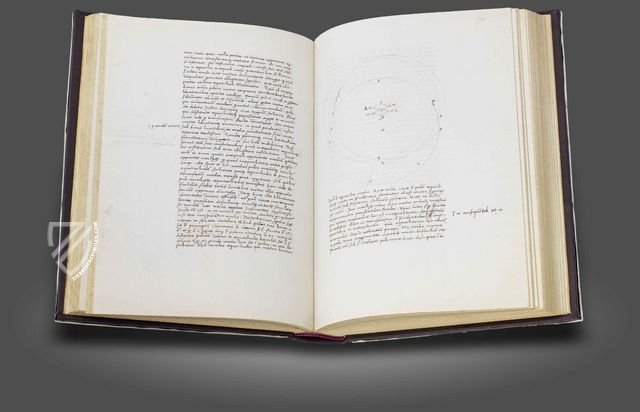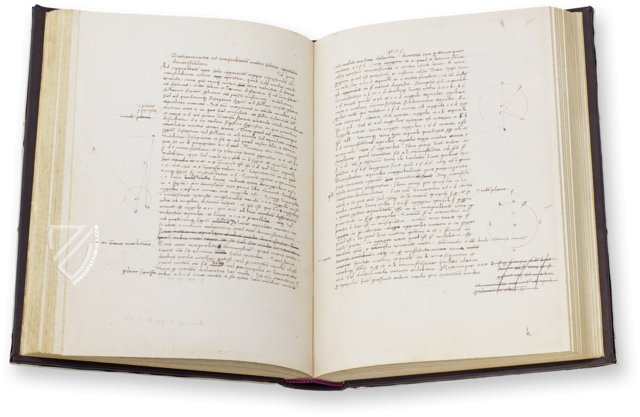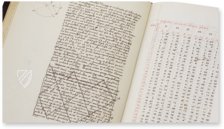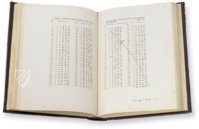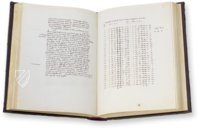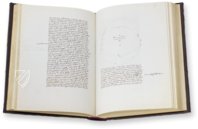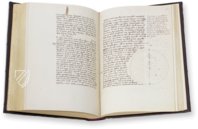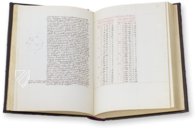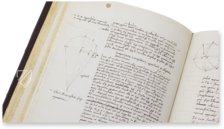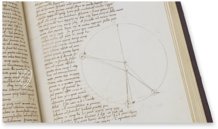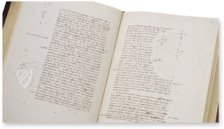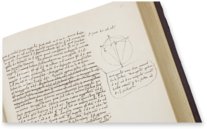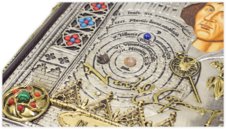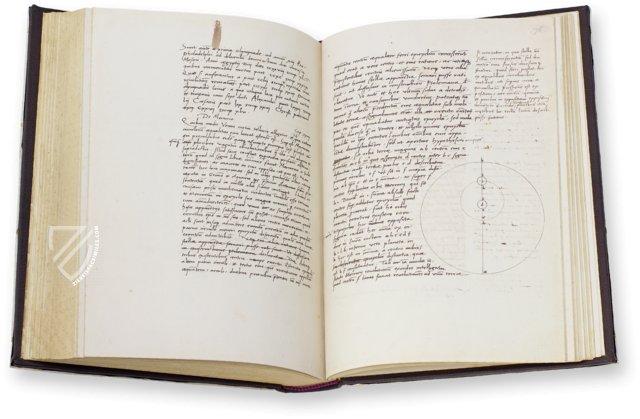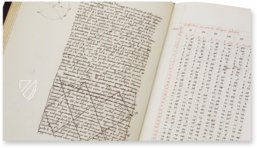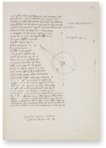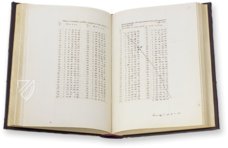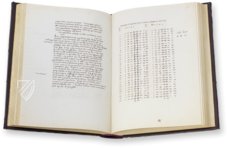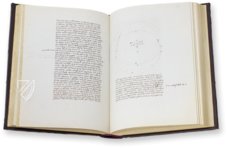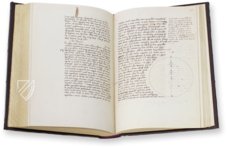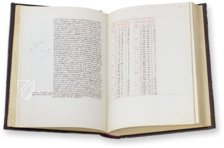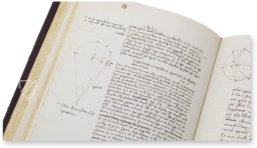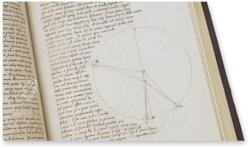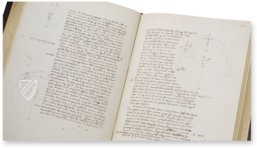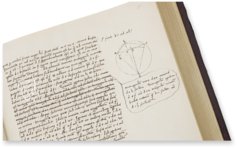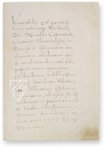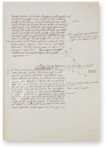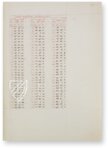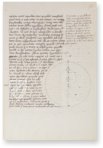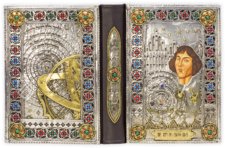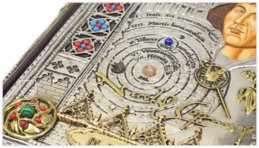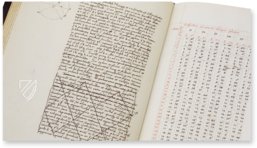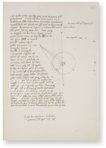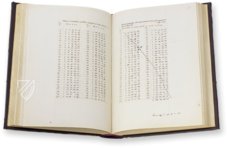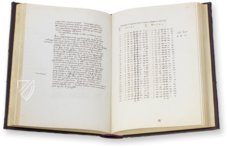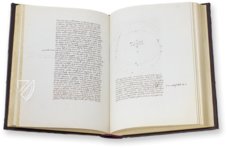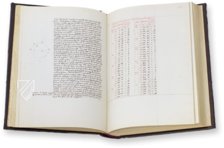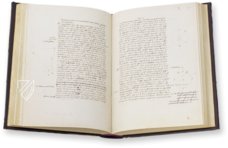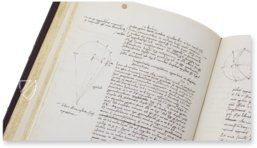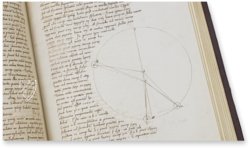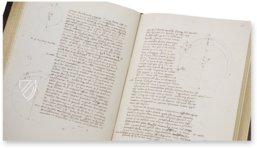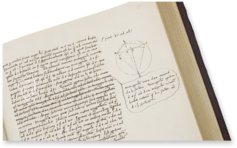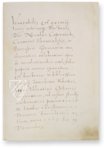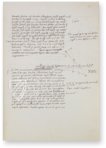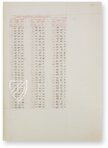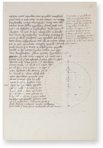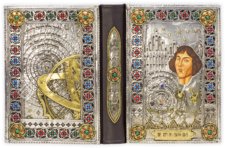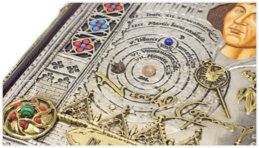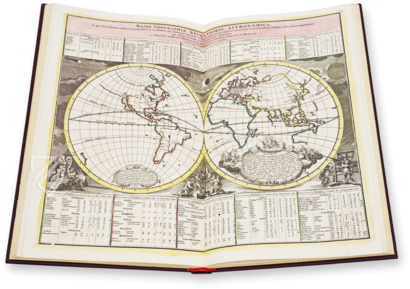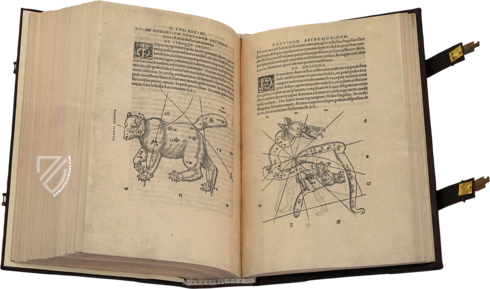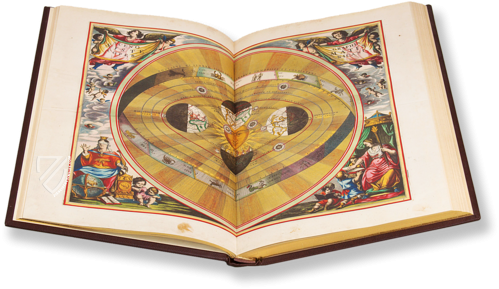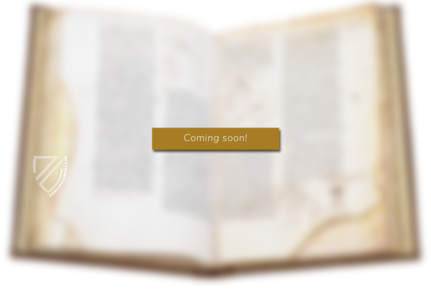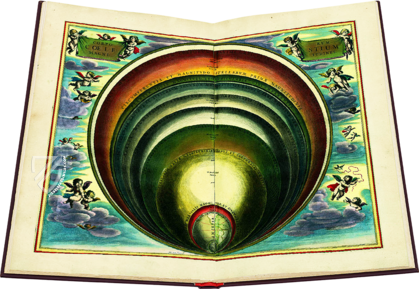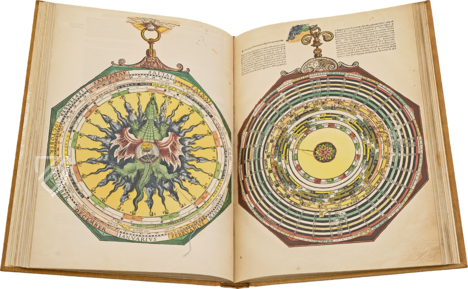Nicolaus Copernicus - De Revolutionibus
(1,000€ - 3,000€)
Few other treatises from the Middle Ages have been of such great significance for science, philosophy, mathematics, and the natural history of the universe as De revolutionibus. The magnum opus of Nicolaus Copernicus was the work of more than 30 years of labor and the original manuscript from the hand of the genius is presented here, which finally made its way back to Cracow after a tumultuous ownership history. The unbelievably influential text is a milestone in the astronomy of the modern era. It provoked a revolution in the thinking of the medieval population and was an absolute standard work of science until the late 18th century. This groundbreaking treatise is housed in a luxury binding consisting of gold and silver, 320 gemstones including turquoises, corals, malachite, lapis lazuli, sunstone, and Swarovski crystals as well as a fragment of the Muonionalusta meteorite, which was discovered in Sweden in 1906. The décor includes a portrait of Copernicus and a depiction of his heliocentric model.
Nicolaus Copernicus - De Revolutionibus
Contrary to popular belief, the title that Nicolaus Copernicus (1473–1543) gave the original manuscript was just De Revolutionibus, the longer title was only applied later to printed edition without the author’s permission. The work belongs among the milestones of astronomy during the modern era. It is a key work of the so-called Copernican Revolution and is considered to be a paradigm for a scientific revolution, in which the reigning medieval geocentric worldview was replaced by a heliocentric one. The findings of Copernicus regarding the Earth and the Universe were groundbreaking in every regard. His theories were based in mathematics and science and did away with religious superstition.
Copernicus’ Original Manuscript
The original manuscript consists of 21 notebooks, so-called signatures, consisting of 8-12 pages each, which are written in neat columns by Copernicus himself. His handwriting varies between a rushed, but shapely italic and an easier, more vertical style. This indicates that the genius was sometimes in a rush to capture the thoughts in his head, while at other times was able to leisurely explore and articulate his ideas. Copernicus filled the margins with 162 geometric figures carefully drawn by hand with a pen, compass, and ruler as well as tables created with a mix of black and red ink.
A Milestone of Astronomy
The work by Copernicus is a milestone of astronomy and its significance for the scientific and cultural history of the modern era can hardly be overestimated. Here, scientific research is very closely linked with philosophical questions. Inspired by the sources of Greek antiquity, above all Aristarchus of Samos, Heraclides Ponticus, and Philolaus, Copernicus developed a new worldview. Accordingly, the Earth moves along its own access and orbits the sun as the central star, like the other known planets. The Earth was seen as the stationary center of the universe for more than two thousand years before Copernicus, who debunked millennia-old, unchallenged arguments against a mobile Earth. He discerned the heliocentric theory through decades of astronomical observations as well as mathematic calculations. Thus, he was able to soundly substantiate his groundbreaking theories. His work possesses such charisma that other scientists, especially Johannes Kepler and Galileo Galilei, built upon it and the great change of perspective was universally accepted only two hundred years later.
From Theory to Publication
Copernicus had already begun recording his theory in a short treatise ca. 1509, the so-called Commentariolus, a few excerpts of which were publically disclosed. After that, he was occupied with its scientific elaboration for 30+ years and began to transcribe his work ca. 1530. Numerous sources from this time exist in which the new theory was disseminated and discussed in the learned circles of Europe. In 1533, Pope Clement VII had his secretary explain it in a lecture.
The Fate of the Precious Manuscript
Held today in Cracow’s Jagiellonian University Library, the original manuscript of De revolutionibus has passed through many hands over the centuries and has an interesting ownership history. After Copernicus’ death, the manuscript was inherited by bishop Tiedemann Giese and later by Georg Rheticus, a doctor at the court of the King of Poland, Sigismund II Augustus (1520-72) in Cracow. After Rheticus’ death it was inherited by his student, Valentine Otho, who took it to Heidelberg where he was a professor of mathematics. After Otho’s death, the manuscript was bought by a professor of astronomy, Jacob Christmann. He had it bound and added a note about the author, which replaced the lost front page, and used parts of the manuscript in his own work about movements of the Moon in 1611.
Disapearence and Rediscovery
Later, the manuscript was bought by Czech scientist, Jan Amos Komeński, who was an opponent of the Copernicus’ theory for his whole life. It is not known when he sold the manuscript, but it is probable that he sold it as he was afraid to keep a book that was listed as a banned in 1616. The fate of the manuscript for the following 50 years remains unknown. In 1677, it was found in the Otto von Nostitz Library where it was registered under the shelf mark MSe21. Nositz’s nephew brought it along with the rest of his library from Silesia to his castle in Prague, where it remained forgotten for many years until it was rediscovered in the 1930’s by the library’s custodian Karl Hillard, PHD. In 1956, the Czech government agreed to exchange the manuscript for the work of some Czech authors, and it was thus returned to Cracow.
Codicology
- Alternative Titles
- Nicolaus Copernicus - De revolutionibus orbium coelestium libri VI
- Size / Format
- 426 pages / 22.8 × 19.8 cm
- Origin
- Germany
- Date
- Ca. 1520–1541
- Epochs
- Style
- Language
- Artist / School
- Nicolaus Copernicus (author)
#1 Nicolaus Copernicus - De Revolutionibus
(1,000€ - 3,000€)
#2 Nicolaus Copernicus - De Revolutionibus
(1,000€ - 3,000€)
- Treatises / Secular Books
- Apocalypses / Beatus
- Astronomy / Astrology
- Bestiaries
- Bibles / Gospels
- Chronicles / History / Law
- Geography / Maps
- Saints' Lives
- Islam / Oriental
- Judaism / Hebrew
- Single Leaf Collections
- Leonardo da Vinci
- Literature / Poetry
- Liturgical Manuscripts
- Medicine / Botany / Alchemy
- Music
- Mythology / Prophecies
- Psalters
- Other Religious Books
- Games / Hunting
- Private Devotion Books
- Other Genres
- Afghanistan
- Armenia
- Austria
- Belgium
- Belize
- Bosnia and Herzegovina
- China
- Colombia
- Costa Rica
- Croatia
- Cyprus
- Czech Republic
- Denmark
- Egypt
- El Salvador
- Ethiopia
- France
- Germany
- Greece
- Guatemala
- Honduras
- Hungary
- India
- Iran
- Iraq
- Israel
- Italy
- Japan
- Jordan
- Kazakhstan
- Kyrgyzstan
- Lebanon
- Liechtenstein
- Luxembourg
- Mexico
- Morocco
- Netherlands
- Palestine
- Panama
- Peru
- Poland
- Portugal
- Romania
- Russia
- Serbia
- Spain
- Sri Lanka
- Sweden
- Switzerland
- Syria
- Tajikistan
- Turkey
- Turkmenistan
- Ukraine
- United Kingdom
- United States
- Uzbekistan
- Vatican City
- A. Oosthoek, van Holkema & Warendorf
- Aboca Museum
- Ajuntament de Valencia
- Akademie Verlag
- Akademische Druck- u. Verlagsanstalt (ADEVA)
- Aldo Ausilio Editore - Bottega d’Erasmo
- Alecto Historical Editions
- Alkuin Verlag
- Almqvist & Wiksell
- Amilcare Pizzi
- Andreas & Andreas Verlagsbuchhandlung
- Archa 90
- Archiv Verlag
- Archivi Edizioni
- Arnold Verlag
- ARS
- Ars Magna
- ArtCodex
- AyN Ediciones
- Azimuth Editions
- Badenia Verlag
- Bärenreiter-Verlag
- Belser Verlag
- Belser Verlag / WK Wertkontor
- Benziger Verlag
- Bernardinum Wydawnictwo
- BiblioGemma
- Biblioteca Apostolica Vaticana (Vaticanstadt, Vaticanstadt)
- Bibliotheca Palatina Faksimile Verlag
- Bibliotheca Rara
- Boydell & Brewer
- Bramante Edizioni
- Bredius Genootschap
- Brepols Publishers
- British Library
- C. Weckesser
- Caixa Catalunya
- Canesi
- CAPSA, Ars Scriptoria
- Caratzas Brothers, Publishers
- Carus Verlag
- Casamassima Libri
- Centrum Cartographie Verlag GmbH
- Chavane Verlag
- Christian Brandstätter Verlag
- Circulo Cientifico
- Club Bibliófilo Versol
- Club du Livre
- CM Editores
- Collegium Graphicum
- Collezione Apocrifa Da Vinci
- Comissão Nacional para as Comemorações dos Descobrimentos Portugueses
- Coron Verlag
- Corvina
- CTHS
- D. S. Brewer
- Damon
- De Agostini/UTET
- De Nederlandsche Boekhandel
- De Schutter
- Deuschle & Stemmle
- Deutscher Verlag für Kunstwissenschaft
- DIAMM
- Droz
- E. Schreiber Graphische Kunstanstalten
- Ediciones Boreal
- Ediciones Grial
- Ediclube
- Edições Inapa
- Edilan
- Editalia
- Edition Deuschle
- Edition Georg Popp
- Edition Leipzig
- Edition Libri Illustri
- Editiones Reales Sitios S. L.
- Éditions de l'Oiseau Lyre
- Editions Medicina Rara
- Editorial Casariego
- Editorial Mintzoa
- Editrice Antenore
- Editrice Velar
- Edizioni Edison
- Egeria, S.L.
- Eikon Editores
- Electa
- Emery Walker Limited
- Enciclopèdia Catalana
- Eos-Verlag
- Ephesus Publishing
- Ernst Battenberg
- Eugrammia Press
- Extraordinary Editions
- Fackelverlag
- Facsimila Art & Edition
- Facsimile Editions Ltd.
- Facsimilia Art & Edition Ebert KG
- Faksimile Verlag
- Feuermann Verlag
- Folger Shakespeare Library
- Franco Cosimo Panini Editore
- Friedrich Wittig Verlag
- Fundación Hullera Vasco-Leonesa
- G. Braziller
- Gabriele Mazzotta Editore
- Gebr. Mann Verlag
- Gesellschaft für graphische Industrie
- Getty Research Institute
- Giovanni Domenico de Rossi
- Giunti Editore
- Graffiti
- Grafica European Center of Fine Arts
- Guido Pressler
- Guillermo Blazquez
- Gustav Kiepenheuer
- H. N. Abrams
- Harrassowitz
- Harvard University Press
- Helikon
- Hendrickson Publishers
- Henning Oppermann
- Herder Verlag
- Hes & De Graaf Publishers
- Hoepli
- Holbein-Verlag
- Houghton Library
- Hugo Schmidt Verlag
- Idion Verlag
- Il Bulino, edizioni d'arte
- ILte
- Imago
- Insel Verlag
- Insel-Verlag Anton Kippenberger
- Instituto de Estudios Altoaragoneses
- Instituto Nacional de Antropología e Historia
- Introligatornia Budnik Jerzy
- Istituto dell'Enciclopedia Italiana - Treccani
- Istituto Ellenico di Studi Bizantini e Postbizantini
- Istituto Geografico De Agostini
- Istituto Poligrafico e Zecca dello Stato
- Italarte Art Establishments
- Jan Thorbecke Verlag
- Johnson Reprint Corporation
- Josef Stocker
- Josef Stocker-Schmid
- Jugoslavija
- Karl W. Hiersemann
- Kasper Straube
- Kaydeda Ediciones
- Kindler Verlag / Coron Verlag
- Kodansha International Ltd.
- Konrad Kölbl Verlag
- Kurt Wolff Verlag
- La Liberia dello Stato
- La Linea Editrice
- La Meta Editore
- Lambert Schneider
- Landeskreditbank Baden-Württemberg
- Leo S. Olschki
- Les Incunables
- Liber Artis
- Library of Congress
- Libreria Musicale Italiana
- Lichtdruck
- Lito Immagine Editore
- Lumen Artis
- Lund Humphries
- M. Moleiro Editor
- Maison des Sciences de l'homme et de la société de Poitiers
- Manuscriptum
- Martinus Nijhoff
- Maruzen-Yushodo Co. Ltd.
- MASA
- Massada Publishers
- McGraw-Hill
- Metropolitan Museum of Art
- Militos
- Millennium Liber
- Müller & Schindler
- Nahar - Stavit
- Nahar and Steimatzky
- National Library of Wales
- Neri Pozza
- Nova Charta
- Oceanum Verlag
- Odeon
- Orbis Mediaevalis
- Orbis Pictus
- Österreichische Staatsdruckerei
- Oxford University Press
- Pageant Books
- Parzellers Buchverlag
- Patrimonio Ediciones
- Pattloch Verlag
- PIAF
- Pieper Verlag
- Plon-Nourrit et cie
- Poligrafiche Bolis
- Presses Universitaires de Strasbourg
- Prestel Verlag
- Princeton University Press
- Prisma Verlag
- Priuli & Verlucca, editori
- Pro Sport Verlag
- Propyläen Verlag
- Pytheas Books
- Quaternio Verlag Luzern
- Reales Sitios
- Recht-Verlag
- Reichert Verlag
- Reichsdruckerei
- Reprint Verlag
- Riehn & Reusch
- Roberto Vattori Editore
- Rosenkilde and Bagger
- Roxburghe Club
- Salerno Editrice
- Saltellus Press
- Sandoz
- Sarajevo Svjetlost
- Schöck ArtPrint Kft.
- Schulsinger Brothers
- Scolar Press
- Scrinium
- Scripta Maneant
- Scriptorium
- Shazar
- Siloé, arte y bibliofilia
- SISMEL - Edizioni del Galluzzo
- Sociedad Mexicana de Antropología
- Société des Bibliophiles & Iconophiles de Belgique
- Soncin Publishing
- Sorli Ediciones
- Stainer and Bell
- Studer
- Styria Verlag
- Sumptibus Pragopress
- Szegedi Tudomànyegyetem
- Taberna Libraria
- Tarshish Books
- Taschen
- Tempus Libri
- Testimonio Compañía Editorial
- Thames and Hudson
- The Clear Vue Publishing Partnership Limited
- The Facsimile Codex
- The Folio Society
- The Marquess of Normanby
- The Richard III and Yorkist History Trust
- Tip.Le.Co
- TouchArt
- TREC Publishing House
- TRI Publishing Co.
- Trident Editore
- Tuliba Collection
- Typis Regiae Officinae Polygraphicae
- Union Verlag Berlin
- Universidad de Granada
- University of California Press
- University of Chicago Press
- Urs Graf
- Vallecchi
- Van Wijnen
- VCH, Acta Humaniora
- VDI Verlag
- VEB Deutscher Verlag für Musik
- Verlag Anton Pustet / Andreas Verlag
- Verlag Bibliophile Drucke Josef Stocker
- Verlag der Münchner Drucke
- Verlag für Regionalgeschichte
- Verlag Styria
- Vicent Garcia Editores
- W. Turnowski Ltd.
- W. Turnowsky
- Waanders Printers
- Wiener Mechitharisten-Congregation (Wien, Österreich)
- Wissenschaftliche Buchgesellschaft
- Wissenschaftliche Verlagsgesellschaft
- Wydawnictwo Dolnoslaskie
- Xuntanza Editorial
- Zakład Narodowy
- Zollikofer AG

